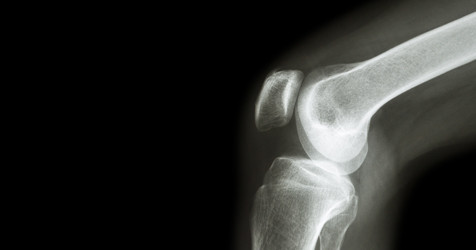Joint replacement surgery is designed to replace the damaged cartilage and any associated loss of bone structure. The procedure itself is a resurfacing of the damaged joint, and relies on the patient's muscles and ligaments for support and function. The prosthesis (replacement joint) is made of titanium, cobalt chrome, stainless steel, ceramic material, and polyethylene (plastic). It can be affixed to the bone with acrylic cement or it can be press-fit, which allows bone to grow into the implant. Once the joint replacement is in place, its motion and function are restored through physical therapy. The three most common joint replacement surgeries are hip, knee, and shoulder.
HIP REPLACEMENT
Total hip replacement is a surgical procedure for replacing the hip socket (acetabulum) and the "ball" or head of the thigh bone (femur). The surgeon resurfaces the socket and ball where cartilage and bone have been lost. An artificial ball and socket are then implanted into healthy bone. Most candidates for total hip replacements have advanced changes in the hip joint caused by arthritis. A hip replacement is recommended if the joint pain has become unbearable and when the loss of function prevents a person from being able to perform activities of daily living.
KNEE REPLACEMENT
Knee replacement surgery is performed 1to treat advanced or end-stage arthritis. When arthritis in the knee joint or joints have progressed to the point where medical management is not effective, or deformity has become severe and debilitating, knee replacement surgery may be recommended. Joint surgery in the knee is a result of damage to the coating or gliding surface called the articular cartilage. Depending on the amount of damage, ordinary activities such as walking and climbing stairs may become difficult. Damage to the knee joint cartilage and underlying bone may also result in deformity. Knock-knee or bow-legged deformities and unusual knee sounds (crepitus) may become more obvious as the degeneration worsens. Knee replacement surgery is designed to replace this damaged cartilage or gliding surface as well as any associated loss of bone structure or ligament support. The material used for knee replacement is similar to that mentioned for hip replacements.
SHOULDER REPLACEMENT
Total shoulder joint replacement is usually required for those who have severe forms of osteoarthritis or rheumatoid arthritis, but more rarely, for those who have sustained severe trauma from a shoulder fracture.Similar to the hip joint, the shoulder is a large ball-and-socket joint. The primary indication for a total shoulder replacement is pain that is not being relieved through therapy or other treatment methods. Pain may be the result of abnormalities and changes in the joint surfaces as a result of arthritis or fractures. The primary goal of total shoulder replacement surgery is to alleviate pain with secondary goals of improving motion, strength, and function.
ANKLE REPLACEMENT
A relatively new treatment option is total ankle replacement. In ankle replacement surgery, an artificial ankle joint is implanted between your lower leg bone and your foot bone. There are a number of artificial ankle devices your surgeon can choose from. They are generally made from metal and plastic parts, and are very durable.
Total ankle replacement surgery is a good alternative to ankle fusion surgery in some patients with ankle arthritis. But before considering total ankle replacement, patients should have tried at least several months of simpler, non-surgical treatment, and must have good soft-tissue coverage and blood flow to the ankle.















